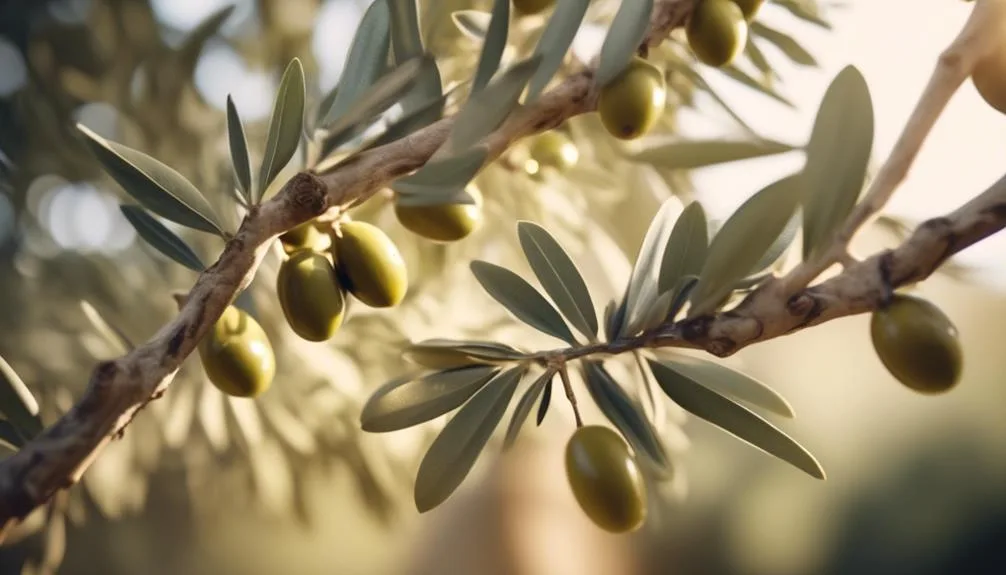Olive trees come in all sorts of varieties, each with its own unique traits. But how can you tell them apart?
The key is to look at the leaves, fruit, growth pattern, bark, and where they're grown. By paying attention to these details, you can learn to recognize the different types of olive trees.
Let's take a closer look at how to identify these diverse and fascinating trees.
Key Takeaways
- Leaf characteristics such as shape and color can vary, with some leaves being narrow and elongated or broader and rounder, and colors ranging from silvery-green to darker green.
- Olive fruits come in various sizes, shapes, and colors, with some being small or large, round or oval, and green, purple, or black.
- Pruning techniques should be based on the specific growth habit of the olive tree, which can be upright, spreading, or weeping. Soil conditions should also be adjusted accordingly, depending on whether the tree prefers well-drained or slightly moisture-retentive soil.
- The bark texture of olive trees changes with age and varies based on climate. Young trees have smooth bark, while older ones develop rough and gnarled bark. Cooler and wetter climates result in thicker and rougher bark, while warmer and drier climates have smoother bark. The bark can range in color from silvery-gray to a darker and more textured appearance.
Leaf Characteristics
Identifying olive tree varieties can be accomplished by carefully examining the leaf characteristics, which are unique to each type of olive tree.
The first key feature to look for is the leaf shape. Different olive tree varieties can have leaves that are narrow and elongated, while others may have broader, rounder leaves.
Additionally, pay attention to the color variation in the leaves. Some olive trees have leaves with a silvery-green hue, while others may have darker green leaves. You might also notice variations in the intensity of the color, with some leaves being a vibrant green and others having a more muted tone.
Fruit Appearance
What distinct features should you look for when examining the appearance of olive tree fruits? When identifying different olive tree varieties based on fruit appearance, it's essential to consider factors such as size, shape, and color. The table below provides a quick reference guide to distinguish between olive varieties based on their fruit appearance.
| Feature | Description | Varieties |
|---|---|---|
| Size | Ranges from small to large | Arbequina, Manzanilla |
| Shape | Varies from round to oval | Kalamata, Mission |
| Color | Can be green, purple, or black | Picual, Frantoio |
Understanding these distinct features is crucial for identifying different olive tree varieties, especially when considering their oil production and culinary uses. By recognizing these characteristics, you can better appreciate the diversity and versatility of olive trees in various applications.
Growth Habit
When examining olive tree varieties, the growth habit plays a significant role in determining the overall health and yield of the trees. Understanding the growth habit of different olive tree varieties can help you make informed decisions about planting and care. Here are some key points to consider:
- Pruning Techniques: Different olive tree varieties have varying growth habits, such as upright, spreading, or weeping. Knowing the specific growth pattern of your olive trees will help you apply appropriate pruning techniques to maintain their shape and promote healthy growth.
- Soil Requirements: The growth habit of olive trees can also influence their soil requirements. Some varieties may prefer well-drained soil, while others may thrive in slightly more moisture-retentive soil. Understanding the growth habit of your olive trees will guide you in providing the ideal soil conditions for optimal growth and fruit production.
Bark Texture
To understand the bark texture of different olive tree varieties, observe the outer layer of the trunk and branches, as it can vary in smoothness, roughness, and coloration.
Olive trees in the Mediterranean region often have smooth bark when they're young, which gradually becomes rough and gnarled as they mature.
The texture of the bark can also vary due to climate differences within the Mediterranean region. In cooler, wetter climates, olive trees tend to have thicker and rougher bark to protect against harsh conditions, while in warmer, drier climates, the bark may be smoother.
Additionally, the coloration of the bark can range from silvery-gray to a darker, more textured appearance.
These variations in bark texture provide valuable clues for identifying different olive tree varieties.
Regional Differences
In the Mediterranean region, regional differences in olive tree varieties can be observed in factors such as growth patterns, fruit size, and oil characteristics. These differences are influenced by climate impact, soil variations, and local agricultural practices.
- Climate Impact: The varying temperatures and precipitation levels in different regions affect the growth and maturation rates of olive trees. Warmer climates often lead to larger fruit size and higher oil content.
- Soil Variations: The composition and pH levels of soil can significantly impact the flavor profile of olives and the quality of the oil produced. For instance, limestone-rich soils often yield olives with a more robust flavor.
- Local Agricultural Practices: Different regions have distinct traditions and methods for cultivating olive trees, leading to variations in pruning techniques, irrigation, and pest management. These practices can further contribute to the unique characteristics of olive tree varieties in different regions.
Conclusion
Mastering the art of identifying different olive tree varieties opens up a world of knowledge and appreciation for these remarkable trees.
From the nuances of leaf and fruit characteristics to the regional influences on growth habits, your newfound expertise will continue to grow with practice.
Embrace the journey of learning and observation, and soon you'll effortlessly discern the unique traits of each olive tree.
Happy exploring!

